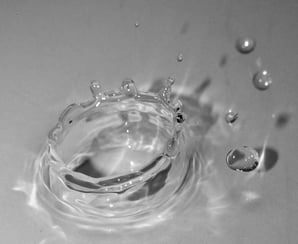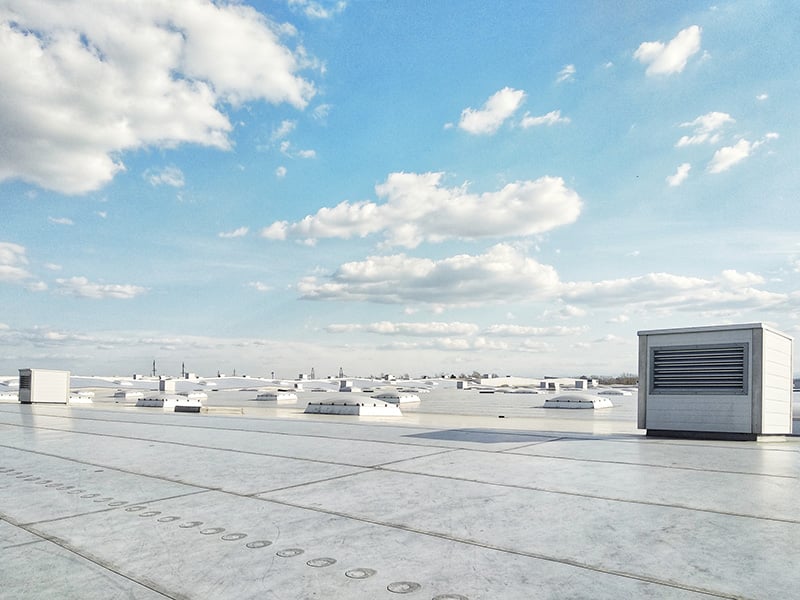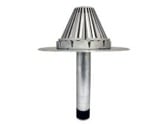All drainage systems are designed as if the piping is full of water, even though the pipe will rarely, if ever, be full.
Reason being, if unaccounted for, the weight of the water in a piping system can negatively impact its durability and effectiveness. Among the primary concerns for engineers and architects are:
1. Piping Clamps or Supports
The total weight (with water), material and diameter of a pipe determine the type and number of clamps or supports needed.
For example, a 6-in. Schedule 40 PVC pipe is going to weigh much more full of water than it will empty, which puts more pressure on the structural strength of the piping material between supports. Because PVC is a flexible material, and a Schedule 40 wall is relatively thin, the pipe has the potential to sag between supports.
Knowing the total pipe weight when full can help engineers determine the appropriate number of supports needed and the associated spacing.
2. Head Pressure
Head pressure is the velocity and force with which water flows through a pipe. The greater the head pressure, the more force is placed on bends and turns throughout the piping system. Head pressure is based on a number of factors, including pipe size, material type, pitch and length of the system.
The weight of water is also a key factor, as the weight of the fluid itself has a compounding effect. The longer and higher the system, the more pressure is created by the water’s own weight. This pressure is greatest in the lower portions of the system.
Green Roof Design
Another area where the weight of water comes into play is on green roofs. Some of these systems are designed to retain water on the roof for insulation and other purposes. The weight of that water requires additional supports be built into the roof top itself to ensure its structural integrity.
Water Weight Conversion Tables
We’ve put together the following tables to help calculate the weight of water and the resultant stress on your piping system.
| Cubic Feet of Water | 62.428 lbs. |
| Gallon | 8.345 lbs. |
| 1 Ounce of Water | 28.35 g |
| Liter | 2.205 lbs. or 1,000 g |
| Cubic Meter | 2,204.5 lbs. |
| 1ppm | 1 lb. per million lbs. |
| 1ppm | 8.34 lbs. per million gallons of water |
| 1ppm | 1 mg per liter of water |
Gallons and Weight of Water per 1 Foot of Pipe
The following data is based on Schedule 40 pipe. Volume and weight may vary based on the Type and Schedule of pipe. Also weight given is for the WATER ONLY, and does NOT included the weight of the pipe.
| Pipe Size (inches) | Gallons of Water in 1 Foot of Pipe | Weight of Water in 1 Foot of Pipe (pounds) NOTE: Does NOT include the weight of the pipe |
| 1/8 | .0006 | .01 |
| 1/4 | .0026 | .03 |
| 3/8 | .0057 | .05 |
| 1/2 | .0102 | .09 |
| 3/4 | .0230 | .20 |
| 1 | .0408 | .34 |
| 1-1/4 | .0638 | .54 |
| 1-1/2 | .0918 | .77 |
| 2 | .1633 | 1.37 |
| 2-1/2 | .2551 | 2.13 |
| 3 | .3673 | 3.07 |
| 4 | .6531 | 5.45 |
| 5 | 1.0204 | 8.52 |
| 6 | 1.4694 | 12.27 |
| 8 | 2.6122 | 21.80 |
| 10 | 4.0816 | 34.06 |
| 12 | 5.8775 | 49.05 |
Conversion Factors
| Multiply | By | To Obtain |
| Acres | 43,560 | Square Feet |
| Atmospheres | 33.90 | Feet of Water |
| Centimeters | 0.3937 | Inches |
| Cubic Feet | 7.48052 | Gallons |
| Cubic Feet | 28.32 | Liters |
| Cubic Feet/Second | 449 | Gallons/min. |
| Cubic Meters | 35.31 | Cubic Feet |
| Cubic Meters | 264.2 | Gallons |
| Cubic Meters | 10^3 | Liters |
| Cubic Yards | 27 | Cubic Feet |
| Cubic Yards | 202.0 | Gallons |
| Feet | 30.48 | Centimeters |
| Feet | 0.3048 | Meters |
| Feet of Water | 62.43 | Lbs./sq.ft. |
| Feet of Water | 0.434 | PSI (lbs./sq.in.) |
| Gallons | 3,785 | Cubic Centimeters |
| Gallons | 0.1337 | Cubic Feet |
| Gallons | 3.785 | Liters |
| Gallons Water | 8.3453 | Pounds of Water |
| Gallons/Minute | 2.228 x 10^-3 | Cubic Feet/sec. |
| Gallons/Minute | 1,440 | Gallons/day |
| Gallons/Minute | 0.06308 | Liters/sec. |
| Gallons/Day | 6.944 x 10^-4 | Gallons/min. |
| Gallons/Day/Sq.Ft. | 1.604 | Inches/day |
| Grams | 2.205 x 10^-3 | Pounds |
| Grams/Liter | 1,000 | Parts/million |
| Hectares | 2.471 | Acres |
| Horsepower | 33,000 | Foot-Lbs./min. |
| Horsepower | 0.7457 | Kilowatts |
| Inches | 2.540 | Centimeters |
| Inches/Day | 0.6234 | Gallons/day/sq.ft. |
| Kilograms | 2.205 | Lbs. |
| Kilowatts | 1.341 | Horsepower |
| Kilowatt-Hours | 2.655 x 10^6 | Foot-lbs. |
| Liters | 10^3 | Cubic Centimeters |
| Liters | 0.03531 | Cubic Feet |
| Liters | 0.2642 | Gallons |
| Meters | 3.281 | Feet |
| Milligrams/Liter | 1 | Parts/million |
| Million Gallons/Day | 1.54723 | Cubic ft./sec. |
| Parts/Million | 8.345 | Lbs./million gal. |
| Pounds | 453.5024 | Grams |
| Pounds of Water | 0.1198 | Gallons |
| PSI (lbs/sq. in.) | 231 | Feet of Water |
| Square Feet | 2.296 x 10^-5 | Acres |
| Temperature (°C) + 17.78 | 1.8 | Temp (°F) |
| Temperature (°F) - 32 | 5/9 | Temp (°C) |
Ask the Roof Drain Wizard

Have any questions about roof drains or water flow? Ask the Hy-Tech Drain Wizard. Call him at 800-635-0384 or email drains@hy-techroof.com.





